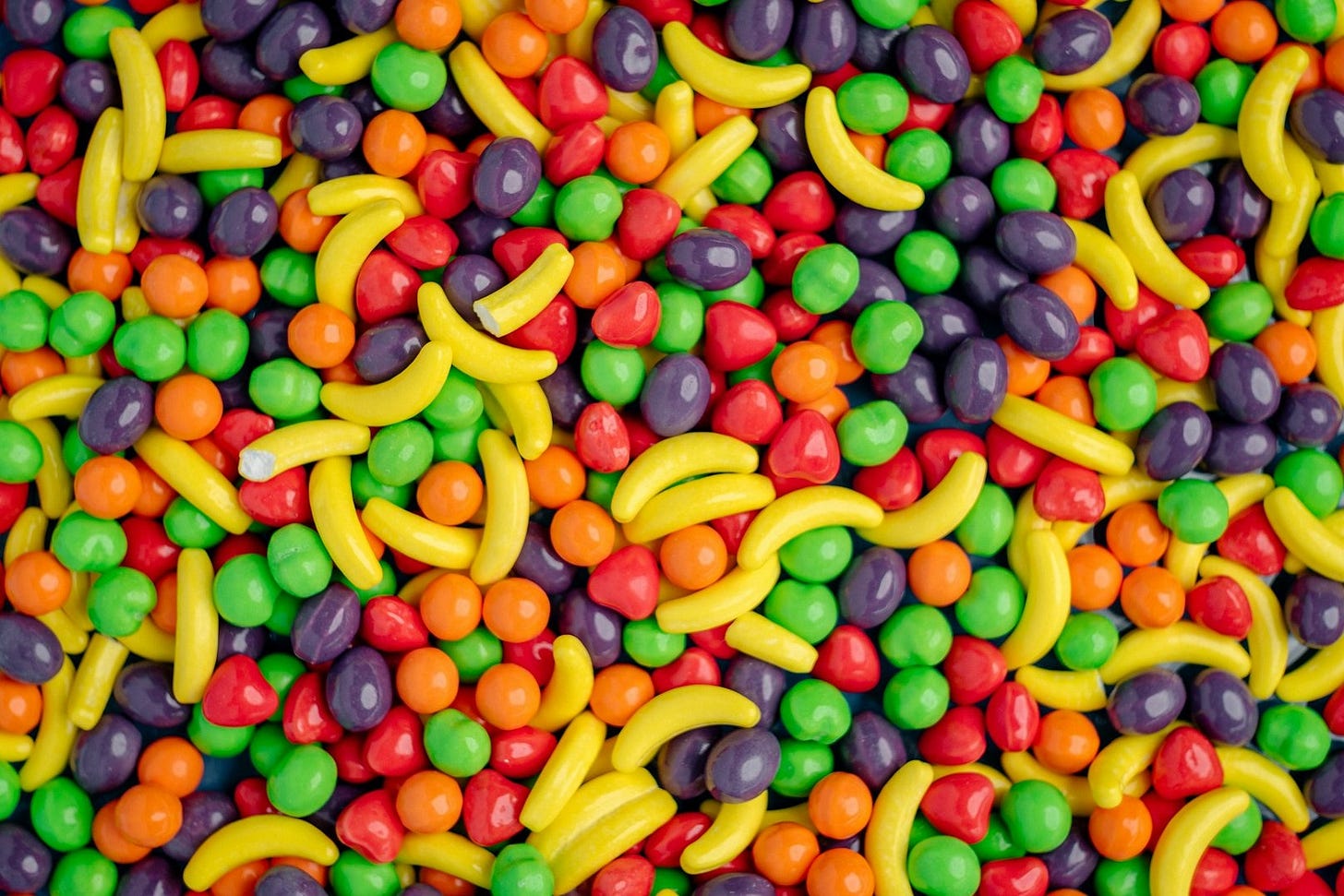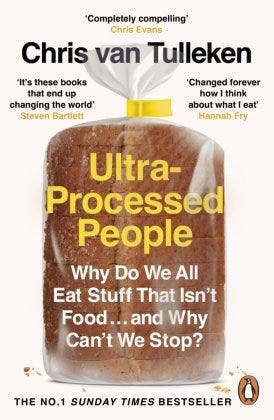Pick an ultra-processed food and have a look at its ingredients list. How many ingredients does it have? Can you find them in your kitchen? Would you eat these ingredients by themselves? Or is this food a concoction of mostly bland ingredients combined for texture, preservation, cheapness, or nutritional claims? Take an Oreo for example - it has 16 ingredients, including flour, oils, alkali-processed cocoa, high fructose corn syrup, baking soda, soy lecithin, and artificial flavour. The well-thought composition of this mixture surely makes it bingeable, but it essentially constitutes an “industrially produced edible substance” - as described by Fernanda Rauber to Chris van Tulleken. This sentence illustrates how, often, processed foods are an amalgamation of bland powders or oils with added salt, sweeteners, and flavour to make them more palatable.
Chris van Tulleken is the author of Ultra-Processed People, a non-fiction book that takes a deep dive into ultra-processed food - a category of food that does not have strict borders yet but is relatively easy to identify. The book is heavy on facts but interesting, well-written, and supported by interviews and studies. Most of all, it is a comprehensive take on everything to be considered about this new landscape of profit-driven food products.
The first representatives of our species, Homo sapiens, appeared around 300,000 years ago1. As omnivorous animals, the human lineage has evolved to find energy and nutrition in an astounding diversity of natural resources. With time, some forms of processing, like cooking with heat, have made foods more digestible and nutrients more available2. Other methods, like salting or fermenting, have helped preserve foods for longer3. However, from a very recent timepoint in human history (late 19th century4, which corresponds to 0.058% of the time Homo sapiens has been around; see the image below), food processing escalated. Now, whole foods get industrially deconstructed into their very basic constituents (for example, corn became corn oil, corn starch, corn syrup, etc.5); foreign additives are added; and ingredients are chemically modified into forms that humans have never encountered in nature before (e.g.: hydrolysed protein, hydrogenated oils).

Our organism has evolved to recognize whole foods consumed in the context of their food matrix. Although we tend to consider food in terms of the macronutrients displayed on nutrition labels - carbohydrates, fat, or protein - these nutrients are not obtained in free form. They are part of a specific physical structure and chemical composition (the food matrix), which includes components like fibre, water, micronutrients, and flavour molecules67. All of these affect how food gets metabolized. For nutrients to become bioaccessible or bioavailable, we cook, chew, and digest them, which changes the rate and amount of nutrient release and absorption.

For example, a classic study from 1977 involved an experiment with apples, whereby scientists learned that drinking apple juice leads to much higher glycemic peaks than eating a whole apple - the release of sugars is much slower when the apple is consumed whole8. The ensuing sugar crash also increases hunger levels.
In ultra-processed foods, macronutrients are delivered in a context that is completely different from their original source. Not only is the food matrix lost, but ingredients are also completely stripped of their micronutrients and other bioactive compounds. Micronutrients are minerals and vitamins obtained through diet, which are essential for different health aspects. Even though they are used as selling points by the ultra-processed food industry, micronutrients are likely more helpful when consumed in the context of their whole foods. For example, nutritional supplements don’t seem to have many health benefits when taken by healthy people910. Furthermore, whole foods contain many more molecules than those manufacturers add back in.

Flavourings are another common addition to ultra-processed foods. Tastes and aromas in food are usually key to modulating appetite and cravings via complex neurological and hormonal systems11. It is hypothesized that individual flavours can indicate the presence of specific nutrients12. In ultra-processed foods, however, flavours are added to products that do not have the corresponding nutritional value. As van Tulleken describes, added flavourings can, in this case, be “a proxy for the low micronutrient content”. These flavours can ramp up the appetite, but as you keep eating, the body’s nutritional needs are not satisfied and this might lead to overconsumption. All the added flavourings are essentially masking empty calories (with low nutritional value)13. Ironically, as van Tulleken writes, “ultra-processing reduces micronutrients to the point that modern diets lead to malnutrition even as they cause obesity.”
(post continues below)
Click below to read my post about salt and how flavour recognition works.
Appetite is also thought to be regulated by protein content (protein leverage hypothesis)1415, a nutrient often low in ultra-processed food.
All the remodelling inflicted on natural foods may thus disrupt the body’s long-evolved ability to recognize macro- and micronutrients and self-regulate food intake according to necessity. Still, processed food packages promise to solve every problem they first started (like lack of structure, fibre, or vitamins) or to follow any new dietary trend (such as low fat or low carb). Every time research uncovers an issue with UPF, the industry takes it as an opportunity to tweak something else and craft a new product marketed as the solution to the consumer’s problems. This leads to endless remodelling replacing the clear solution of eating whole foods. Crucially, the negative impact of ultra-processed foods on our health seems to persist1617.

Recognizing ultra-processed foods
In 2009, a team of researchers at the University of São Paulo in Brazil proposed the NOVA classification system to group distinct groups of foods according to the extent to which they are processed18. The groups comprise:
In the last group - ultra-processed foods -, foods are deconstructed, deprived of nutrients, and complemented with artificial ingredients. These ingredients, as explained in the book, often have a low barrier to entering the market and end up being self-determined as safe by the companies that use them. As this new landscape of food has emerged so recently in the history of the human diet, the effects of these formulations and ingredients on the body are yet to be fully understood.
Cheap, quick, and hyper-palatable foods certainly provide relief to a main struggle of modern life - busy days without much time to cook. However, if this results in overconsumption and poor health, all the saved time and money may be wasted. Though often these products may be our only or most suitable option, being informed can at least help us make conscious choices and hopefully fight back against the total extinction of accessible and affordable whole foods.
If you are interested in the subject, I recommend grabbing a copy of Chris van Tulleken’s Ultra Processed People, where you can get a thorough understanding of the impact ultra-processed foods can have on us - as individuals, as a society, and as part of a larger ecosystem.
https://www.nhm.ac.uk/discover/news/2017/june/oldest-known-homo-sapiens-fossils-discovered-in-morocco.html
https://pubmed.ncbi.nlm.nih.gov/19732938/
https://nchfp.uga.edu/resources/entry/historical-origins-of-food-preservation
https://www.scientificamerican.com/article/processed-food-a-two-million-year-history/
https://cobfoods.com/blogs/news/the-1800-and-counting-corn-derivatives-you-never-would-have-guessed
https://www.bbc.co.uk/food/articles/food_matrix
https://academic.oup.com/nutritionreviews/article-abstract/65/10/439/1879933
https://www.thelancet.com/journals/lancet/article/PIIS0140-6736(77)90494-9/fulltext
https://pmc.ncbi.nlm.nih.gov/articles/PMC6353240/
https://pmc.ncbi.nlm.nih.gov/articles/PMC8407395/
https://journals.sagepub.com/doi/10.1177/0301006616685576
https://www.nytimes.com/2015/06/14/books/review/the-dorito-effect-by-mark-schatzker.html
https://www.health.harvard.edu/staying-healthy/understanding-empty-calories
https://onlinelibrary.wiley.com/doi/10.1111/obr.12131
https://www.nature.com/articles/s41366-023-01455-6
https://harvardpublichealth.org/policy-practice/processed-foods-make-us-sick-its-time-for-government-action/
https://bmjgroup.com/consistent-evidence-links-ultra-processed-food-to-over-30-damaging-health-outcomes/
https://ecuphysicians.ecu.edu/wp-content/pv-uploads/sites/78/2021/07/NOVA-Classification-Reference-Sheet.pdf








What an excellent piece about an enormously important issue. Thank you.